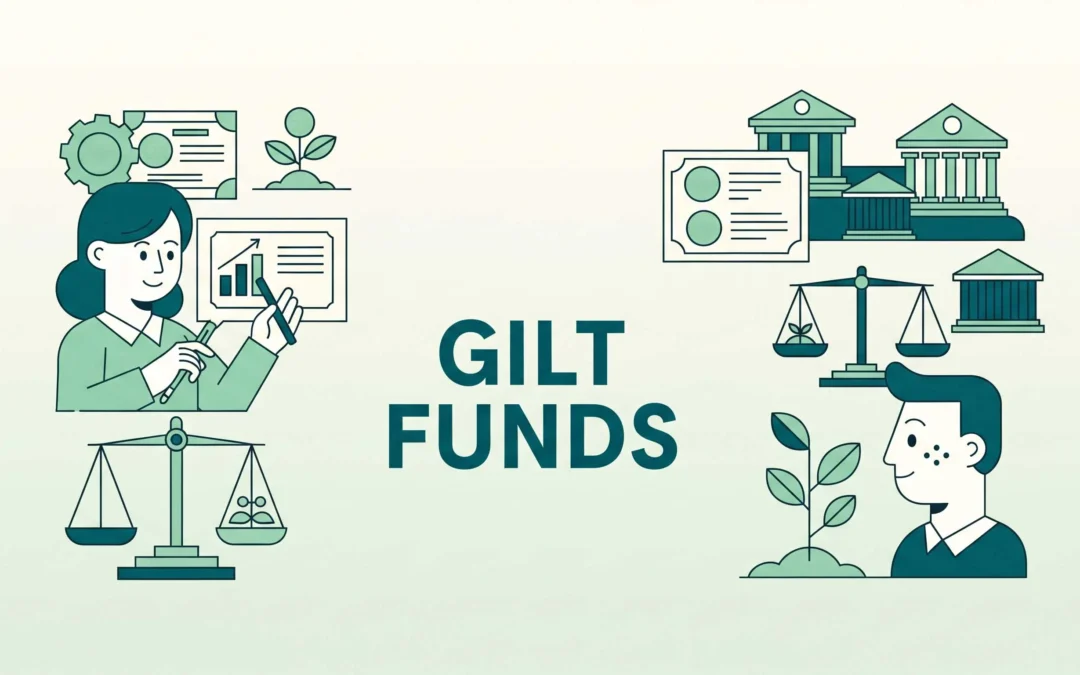The world of investing is expanding rapidly. Investors are offered different types of mutual funds as an investment option, depending on their objectives. There is a right fit for every investor. One of such options is Gilt Funds, that has very little risk associated with them. You might think Why so? Also, are they a suitable choice for long-term investors?
This article will answer all your questions and help you provide deep insights into Gilt funds so that you can choose whether to invest in them or not. It will also help you know if they will form a valuable part of your portfolio or not. Let us start with understanding the meaning of it.
What are Gilt Funds?
Gilt funds are a type of mutual fund that mainly invests in government securities. Due to their government backing, these securities carry almost no credit risk. Individuals may misinterpret it as risk-free, which is not the case. They are liable to changes in interest rates, which may result in variations in returns.
These funds are frequently considered by investors seeking capital preservation with modest returns and no exposure to credit. This type of fund performs well during periods of falling interest rates, when bond prices rise, potentially leading to capital gains.
Key Features of Gilt Funds:
- Minimal chance of default: Since only government securities are invested in, there is no default risk.
- Interest Rate Sensitivity: These funds are highly impacted by changes in interest rates. Example: Bond prices increase when interest rates decline, giving investors capital gains.
- Absence of Corporate Debt Exposure: Unlike other debt funds, they avoid making investments in corporate debentures or bonds.
- Medium to Long-Term Duration: These funds are better suited for long-term investors because they usually hold securities with medium to long durations (3–10 years).
- Transparent Portfolio: The portfolio is simple to monitor and comprehend because government securities are publicly traded.
Who Should Invest in Gilt Funds?
Here is a thorough examination of the most suitable investors for these funds:
1. Long-term, cautious investors
Perfect for people who don’t want to worry about credit defaults and want safety with moderate returns over a period of five to ten years.
An illustration would be a parent setting aside money for their child’s college expenses in ten years.
2. Allocators of Strategic Assets
Excellent for adding credit-risk-free government securities to a debt portfolio. To balance overall risk, an investor might combine gilt funds (which carry interest rate risk) with corporate bond funds (which carry credit risk).
3. Investors Aware of Interest Rates
Those who can potentially profit from investments by timing them around declining interest rates.
An investor investing in them before an RBI rate cut is an example.
4. Retirees
Retirees who prioritize low credit risk may consider gilt funds as part of a diversified portfolio. However, since gilt fund returns can fluctuate, they do not offer predictable or guaranteed income. For retirees seeking regular income, other options like the Senior Citizen Savings Scheme (SCSS) or monthly income plans might be more appropriate.
Who Should Avoid Gilt Funds?
1. Investors with a short time horizon:
Goals under three years are not the best fit.
For instance, NAVs may fluctuate for someone saving for a trip the following year.
2. Investors Looking for Fixed Returns:
Interest rate fluctuations affect gilt fund returns, reducing the possibility of getting fixed returns.
Example: An investor may consider a fixed deposit instead of Gilt funds as they offer guaranteed returns.
3. NAV-Averse to Risk Volatility:
Short-term returns may be negative; sensitive to market rates.
For instance, a novice investor who finds short-term losses unsettling.
4. Uninformed Retail Investors:
Retail investors who are ignorant of rate cycles may make poorly timed entries.
For instance, an investor who purchases during a period of rate hikes may experience immediate losses.
Should You Consider Gilt Funds for Long-Term Investing?
Let us look at the pros and cons of deciding whether gilt funds are suitable for long-term investing or not.
Pros of Gilt Funds:
- No Credit Risk: The safest type of debt in India is government securities, which is where your money is invested. Unlike corporate bond funds, there is no default risk.
- Interest Rate Cycle Advantage: Existing bonds gain value when interest rates decline. High capital gains can be generated by long-duration gilt funds during these times, which increases their allure over the long run.
- Expert Management: Over time, fund managers actively control durations to optimise returns and reduce interest rate risks.
Cons of Gilt Funds:
- NAV Volatility: When interest rates fluctuate, prices may as well. For example, bond prices and, consequently, fund NAVs decline during a rising interest rate cycle.
- Long-Term Dedication Is Required: It is advised to hold gilt funds for five to ten years in order to reap the full benefits. Exiting during a period of rate hikes could result in losses for short-term investors.
- No Guaranteed Returns: In contrast to PPF or fixed deposits, returns are subject to market fluctuations and may differ from year to year.
Bottomline
After looking at the suitability and pros and cons of gilt funds, investors may get a clear picture of whether to invest in them or not. It highly depends on the investment objective of the investor. It is suitable for long-term investors who want low-risk investment options. People who do not worry about short-term fluctuations are also a suitable fit.
Gilt funds as a part of a diversified portfolio may help in balancing risk and return. Smartly incorporating it in your portfolio will not only help in the preservation of wealth but also in beating inflation.
Written by: Tanya Kumari


